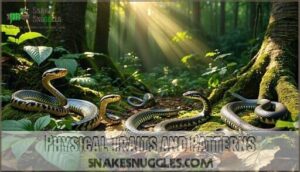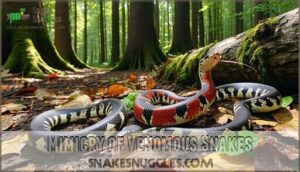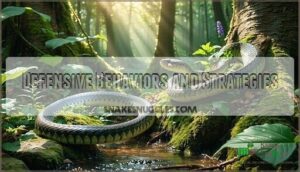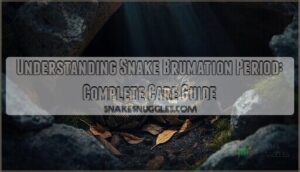This site is supported by our readers. We may earn a commission, at no cost to you, if you purchase through links.
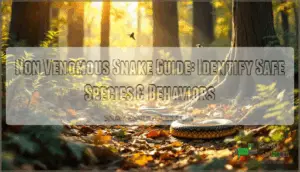 Most people freeze when they spot a snake, unsure whether they’re looking at a harmless garden dweller or something dangerous. That split-second panic is understandable—snake identification isn’t exactly taught in school. Yet the vast majority of snakes you’ll encounter pose zero threat to humans. Learning to recognize non-venomous species transforms fear into fascination.
Most people freeze when they spot a snake, unsure whether they’re looking at a harmless garden dweller or something dangerous. That split-second panic is understandable—snake identification isn’t exactly taught in school. Yet the vast majority of snakes you’ll encounter pose zero threat to humans. Learning to recognize non-venomous species transforms fear into fascination.
Round pupils, smooth scales, and slender heads are your first clues, but there’s much more to discover. This guide walks you through the physical traits, behaviors, and ecological roles that set harmless snakes apart from their venomous cousins, giving you the confidence to coexist peacefully with these misunderstood reptiles.
Table Of Contents
- Key Takeaways
- Non Venomous Snake Basics
- Identifying Non Venomous Snakes
- North American Species Guide
- Defensive Behaviors and Strategies
- Benefits and Misconceptions
- Frequently Asked Questions (FAQs)
- What is the most friendly non-venomous snake?
- How to identify a non-venomous snake?
- How do you handle a non-venomous snake?
- What are the most harmless snakes?
- How can I safely handle non-venomous snakes?
- Do non-venomous snakes pose any health risks?
- What should I do if bitten by one?
- Can non-venomous snakes coexist with pets?
- How do I deter snakes from my property?
- How do you safely relocate a non-venomous snake?
- Conclusion
Key Takeaways
- Non-venomous snakes are identified by round pupils, smooth scales, and slender heads, while their defensive behaviors include freezing, fleeing, and emitting musk rather than attacking.
- These harmless snakes play a critical ecological role by controlling rodent and pest populations, serving as natural pest control for agriculture and maintaining ecosystem balance.
- Common North American species like the Eastern Ratsnake, Milk Snake, and Northern Water Snake are often mistaken for venomous snakes due to mimicry patterns, but proper identification through physical traits prevents unnecessary fear.
- Non-venomous snakes rarely bite unless cornered as a last resort, and their presence serves as an environmental health indicator, signaling biodiversity and habitat quality.
Non Venomous Snake Basics
Non-venomous snakes are some of the most misunderstood creatures you’ll encounter in nature. Understanding what makes a snake harmless—from physical traits to behavior—can transform fear into appreciation.
Let’s explore the basics that will help you recognize these beneficial reptiles and understand their role in your local environment.
Characteristics of Non Venomous Snakes
You can tell a lot about a snake by the shape of its pupils, the texture of its scales, and whether its head looks more like a spoon or an arrowhead. Nonvenomous snakes usually show round pupils, smooth scales, and slender head shapes—signs you’re dealing with harmless snakes. Here’s what sets nonvenomous snake species apart:
- Pupil types: Round, not slit-like
- Snake scale patterns: Smooth textures
- Body colors: Varied, from browns to vibrant reds
- Constriction methods: They squeeze, don’t inject venom
These snake characteristics make snake identification straightforward once you know what to look for.
Habitats and Ecological Roles
Non-venomous snake species occupy nearly every habitat on Earth—forests, prairies, wetlands, and rocky hillsides. This habitat diversity maintains ecosystem balance by allowing snakes to control rodents, insects, and other prey across varied landscapes.
As ecological indicators, their presence signals healthy wildlife management and environmental quality. Snake conservation protects these ecological roles, ensuring snake diversity and ecology continue benefiting natural and agricultural systems through effective pest control and nutrient cycling.
Understanding snake species differences is essential for developing effective conservation strategies.
Importance in Ecosystems
When these serpents vanish from an area, the ripple effects can destabilize entire food webs. Rodent populations explode without non-venomous snakes as natural predators, threatening crops and spreading disease. This pest control service protects agricultural systems and maintains ecosystem balance.
Without snakes controlling rodents, crops fail and disease spreads—these silent predators keep entire ecosystems from collapse
As prey for hawks and foxes, these snakes strengthen biodiversity conservation by fueling species interactions. Their presence indicates ecological harmony—a sign that nutrient cycling and snake diversity and ecology remain intact. Conservation efforts safeguarding these reptiles protect the ecological importance of snakes across landscapes.
Identifying Non Venomous Snakes
Knowing how to tell a harmless snake from a dangerous one can save you a lot of worry when you spot one in your yard or on a trail. You don’t need to be an expert—just a few reliable clues can point you in the right direction.
Let’s walk through the key traits that help you identify non-venomous snakes with confidence.
Physical Traits and Patterns
If you’ve ever wondered how snakes manage to look so different from one another, their physical traits hold all the answers. Non-venomous snakes display striking physical characteristics that help with identification. You’ll find distinctive features like:
- Longitudinal stripes running head to tail
- Bold bands encircling the body
- Smooth scale texture versus keeled patterns
- Rounded head shapes rather than triangular
- Unique body markings showing blotches or spots
Pattern recognition becomes easier when you study snake patterns and color morphs. These appearance details reflect nature’s creativity and help you confidently identify non-venomous snakes in the field.
Coloration and Size Variations
Colors are the snake world’s language—bright warnings, clever disguises, and honest declarations of who’s harmless and who’s not. Non-venomous snakes show striking coloration variety, from the corn snake’s vibrant orange-red blotches to the smooth green snake‘s perfect meadow camouflage.
Snake pattern differences help you with snake identification—look for longitudinal stripes, bold bands, or subtle scale texture variations. Body length ranges dramatically too: tiny ringneck snakes barely reach a foot, while eastern ratsnakes stretch over six feet.
These snake characteristics and color morphs reflect each snake species’ habitat and lifestyle, making identification easier once you know what you’re looking for.
Mimicry of Venomous Snakes
Mimicry tactics are nature’s sleight of hand, giving non venomous snakes a fighting chance against curious predators. These snakes, masters of adaptive coloration, often imitate venomous lookalikes—think milk snakes “dressed” just like coral snakes. It’s called evolutionary mimicry, and it’s one of nature’s best snake camouflage tricks. Learning these patterns sharpens your snake identification skills and builds respect for each snake’s survival story. Understanding the concept of warning coloration types is essential for recognizing the differences between venomous and non-venomous species.
- Non venomous snakes use mimicry to discourage would-be attackers
- Snake behavior and coloration evolve for defense, not deception
- Distinguishing mimics from true venomous snakes keeps you safe
North American Species Guide
North America is home to dozens of non-venomous snake species that you’ll likely encounter in fields, forests, and even your backyard. Learning to recognize these harmless snakes helps you coexist peacefully with them and appreciate their role in controlling pests.
Let’s explore some of the most common species you might meet across the continent.
Eastern Ratsnake and Ribbon Snake
You’ll find the Eastern Ratsnake and Ribbon Snake among North America’s most beneficial non-venomous snakes. The Eastern Ratsnake can stretch beyond 80 inches, making it one of the longest species in the region, while Ribbon Snakes stay slimmer at 18 to 34 inches. Both excel at rat snakes’ natural talent—pest control—but their snake habitat preferences differ.
- Eastern Ratsnake: thrives in wooded areas across Virginia, Maryland, and Delaware
- Ribbon Snake: prefers wetland edges near ponds and streams with bright yellow stripes
- Ratsnake Behavior: uses constriction to subdue rodents and small mammals
- Species Comparison: both are daytime hunters supporting snake conservation through natural pest management
Understanding snake identification helps you appreciate these harmless helpers and promotes snake safety in your backyard.
Northern Red-Belly and Milk Snake
The Northern Red-Belly Snake, one of the smallest non-venomous snakes at 8 to 10 inches, hides under leaf litter in northeastern forests where its Red Belly Diet focuses on slugs and insects.
In contrast, the Milk Snake reaches 36 inches and uses striking mimicry patterns—reddish-brown blotches bordered in black—for snake identification challenges.
Both harmless snakes share habitat preferences for cover-seeking snake behavior, though Milk Snake Breeding occurs in varied terrains from New England woodlands to Midwestern prairies, supporting their stable conservation status through natural snake migration patterns.
Northern Watersnake and Other Species
If you’ve spotted a snake gliding through water with dark blotches along its back, you’re likely looking at a Northern Water Snake—one of the most misunderstood Non Venomous Snakes in Aquatic Habitats.
Reaching 24 to 55 inches, these adaptable swimmers inhabit streams from Maine to Alabama, playing a key role in Ecosystem Balance by controlling fish and amphibian populations through their diverse Watersnake Diet.
Though their Species Adaptation allows them to thrive in varied wetland environments, they’re often confused with venomous cottonmouths during Snake Identification—a reminder that Snake Safety starts with understanding behavior, not just appearance.
Texas and Alabama Non Venomous Snakes
Texas and Alabama together boast over 80 Non Venomous Snakes, showcasing impressive Snake Habitat Diversity across prairies, forests, and wetlands.
You’ll find Regional Species like the western ribbon snake and plain-bellied water snake thriving in aquatic environments, while ground snakes and striped whipsnakes navigate grasslands.
Understanding these Snake Behavior Patterns through proper Snake Identification fosters Conservation Efforts and highlights their Local Ecosystem Impact. These Harmless Snakes control rodents and maintain balance, proving Snake Safety starts with knowledge, not fear.
Defensive Behaviors and Strategies
When you stumble upon a non-venomous snake, it won’t attack—it’ll do everything it can to avoid you.
These harmless reptiles have evolved several clever strategies to stay safe when they feel threatened. Let’s look at the three main ways non-venomous snakes defend themselves without relying on venom.
Freezing and Fleeing Mechanisms
When danger looms, a non-venomous snake’s first move is to freeze in place and hope you walk right past it. This Freeze Response relies on Snake Camouflage—staying motionless makes them nearly invisible against leaves, grass, or rocks. If you spot them anyway, these Harmless Snakes switch to Fleeing Techniques:
- Rapidly slithering into dense vegetation
- Diving underwater to escape detection
- Burrowing beneath leaf litter or debris
- Racing toward rock crevices or hollow logs
- Zigzagging through terrain to confuse predators
These Escape Strategies show how Non Venomous Snakes prioritize Threat Avoidance over confrontation, making Snake Identification and Snake Safety easier for everyone.
Striking and Biting as Last Resort
If cornering or restraint leaves no escape route, even the gentlest snake may lunge forward with a defensive bite. These strikes lack venom and rarely break the skin, but they serve as clear warning signs to back off. Understanding snake behavior helps with attack prevention.
| Defensive Postures | Snake Aggression Level | Bite Wounds |
|---|---|---|
| Coiled, head raised | Moderate warning | Superficial scratches |
| Flattened body, hissing | High alert | Minor punctures |
| Calm observation | No threat | None |
Recognizing these cues in harmless snakes improves snake safety and snake identification during encounters with non-venomous snakes.
Emitting Musk and Vibrating Tails
Some non-venomous snakes take their act a step further with chemical warfare and sound effects that would fool most predators. Musk emission releases a pungent, foul-smelling substance from glands near the tail—nature’s version of pepper spray. Tail vibrations against dry leaves create a buzzing rattle that mimics venomous species, a clever bluff in snake communication. These defensive mechanisms work together as warning signals to deter threats.
Recognizing these behaviors improves snake identification and safety:
- Sudden tail shaking in leaf litter mimics rattlesnake sounds
- Strong musky odor lingers after encounters with harmless snakes
- Defensive postures combined with these signals indicate high stress levels
Understanding snake behavior and habitat helps you respect their space.
Benefits and Misconceptions
Non-venomous snakes offer more benefits than most people realize, from protecting crops to signaling a thriving ecosystem. Yet myths and misunderstandings often cloud how we view these helpful reptiles.
Let’s clear up what’s true and what’s not about their role in nature, their habits, and their patterns throughout the year.
Controlling Pest Populations and Agriculture
Most farmers don’t realize their best pest control workers never ask for a paycheck—they just need a place to hunt. Non-venomous snakes excel at pest management by consuming rodents that damage grain stores and spread disease. This natural pest control method bolsters ecosystem balance without chemical intervention.
| Snake Species | Agricultural Benefits |
|---|---|
| Eastern Ratsnake | Protects grain silos from rodent damage |
| Bullsnake | Controls gopher and vole populations in fields |
| Garter Snake | Reduces insect pests in vegetable gardens |
| Corn Snake | Safeguards stored crops from mice infestations |
Supporting snake conservation means embracing sustainable pest control methods that improve crop protection while respecting snake behavior and ecosystem health.
Environmental Health Indicators and Misconceptions
Ecosystem Balance hinges on creatures often misunderstood—non-venomous snakes serve as biodiversity indicators, revealing environmental health through their presence or absence. When pollution disrupts habitats, snake populations decline first, making them essential for environmental monitoring and conservation efforts. Yet misconceptions persist, overshadowing their role in wildlife preservation and biodiversity support:
- They aren’t slimy—their scales are dry and smooth
- They don’t chase people—snake behavior involves fleeing when threatened
- They won’t swallow their young—this myth has no basis in reality
- They’re selective eaters—focused on rodents and pests, not random attacks
Supporting snake conservation means protecting nature’s early warning system for ecosystem troubles.
Snake Size, Activity, and Hibernation Patterns
Non-venomous snakes range from pencil-thin ribbon snakes barely a foot long to muscular rat snakes stretching over six feet, with their size and behavior shifting dramatically as temperatures drop. During winter, hibernation cycles kick in—these snakes seek underground dens or rock crevices for brumation.
Activity patterns change seasonally:
- Spring emergence brings peak feeding and mating
- Summer heat drives nocturnal hunting schedules
- Fall preparation involves intensive feeding before dormancy
- Wintering behaviors include communal denning with other snake species
- Snake growth rates slow markedly during brumation periods
Understanding these size variations and snake activity helps you predict when you’ll encounter non-venomous snakes.
Diet, Mating, and Egg-Laying Habits
A garter snake’s hunting strategy differs entirely from its courtship dance, yet both behaviors reveal the adaptive genius that keeps these reptiles thriving across diverse landscapes. Snake feeding habits range from garter snakes ambushing earthworms to rat snakes constricting mice—their hunting tactics match available food sources. Snake mating season sparks competitive rituals where males follow pheromone trails to receptive females. Reproductive cycles vary dramatically: some species lay clutches of leathery eggs in warm soil, while others like garter snakes give live birth.
| Species | Diet & Hunting Tactics | Reproductive Methods |
|---|---|---|
| Garter Snake | Earthworms, amphibians; ambush predator | Live birth (5-40 young) |
| Rat Snake | Rodents, birds; constrictor | Egg laying (12-20 eggs) |
| Milk Snake | Small mammals, lizards; constrictor | Egg laying (10-24 eggs) |
| Water Snake | Fish, amphibians; aquatic hunter | Live birth (20-50 young) |
Understanding snake behavior and diet reveals how snake social interactions peak during spring mating season, when multiple males compete for females through elaborate courtship displays.
Frequently Asked Questions (FAQs)
What is the most friendly non-venomous snake?
Corn snakes top the list for snake friendliness—they’re gentle, calm, and rarely bite. Their easy-going temperament makes them perfect for interaction.
Garter snakes also rank high among harmless snakes, with curious, docile personalities that shine during friendly encounters.
How to identify a non-venomous snake?
Reading a snake is like deciphering nature’s code. Look for round pupils, a head that flows smoothly into the neck, and smooth scale patterns. Check the pupil shape carefully: circular eyes usually signal safety.
Notice the snake body shape too—slender and uniform usually means harmless. When identifying nonvenomous snakes, remember that some cleverly mimic their dangerous cousins, so observe multiple characteristics together before drawing conclusions.
How do you handle a non-venomous snake?
Stay calm when you encounter harmless reptiles.
Support the snake’s body gently—never grab its tail or neck. Use proper snake management tips like a snake hook for gentle restraint and escape prevention.
Wash your hands afterward for snake safety.
What are the most harmless snakes?
Garter snakes, Eastern ratsnakes, and ribbon snakes rank among the most harmless species you’ll encounter. These gentle giants are nonvenomous, naturally shy, and serve as nature’s pest control.
They’ll retreat rather than attack—just stay calm and respect their space.
How can I safely handle non-venomous snakes?
Think of snake manipulation like catching a flowing stream—you’re guiding movement, not stopping it. Support their body gently behind the head while letting them move through your hands. Stay calm; sudden movements stress them out.
Use snake manipulation equipment like hooks for safety precautions. Always wash hands afterward since harmless snakes carry bacteria.
Proper gentle restraint and snake identification keep both you and non-venomous snakes safe during manipulation.
Do non-venomous snakes pose any health risks?
Yes, harmless snakes can still bite when threatened, potentially introducing bacteria that may cause infection if left untreated.
Wash any snake bites thoroughly with soap and water, and watch for signs of infection like redness or swelling.
What should I do if bitten by one?
Oddly, even harmless snakes can cause worry. If bitten, stay calm and wash the wound with soap and water immediately. Apply a clean bandage and watch for swelling or irritation.
Seek medical attention if symptoms worsen—better safe than sorry.
Can non-venomous snakes coexist with pets?
With proper supervision, pet snake encounters can be managed safely. Dogs and cats often show curiosity toward non-venomous snakes, so keep pets leashed outdoors and use snake-proof fencing where possible. Never allow your pet to chase or harass snakes—this benefits both animals.
How do I deter snakes from my property?
You’ve probably heard that snakes avoid open, tidy spaces—and it’s true. Clear debris and trim vegetation to eliminate hiding spots.
Seal entry points, remove rodents, and consider snake-proof fencing for property maintenance and backyard ecosystem balance.
How do you safely relocate a non-venomous snake?
If you’ve identified a non-venomous snake that needs relocation, use a long-handled snake hook or thick gloves for safe management. Gently guide it into a secure container, then release it at least a mile away in suitable habitat.
For wildlife removal concerns, contact local professionals trained in snake safety.
Conclusion
Knowledge is half the battle—the other half is knowing when to walk away. Understanding this non venomous snake guide gives you the tools to replace fear with respect.
You’ve learned to spot round pupils, recognize harmless species, and appreciate their role in keeping ecosystems balanced.
Next time you cross paths with a snake, you won’t panic. You’ll pause, observe, and let nature take its course. That shift from dread to curiosity changes everything.
- https://extension.psu.edu/snakes
- https://www.lawnstarter.com/blog/pest-control/garter-snake-in-the-garden-let-it-be/
- https://www.denix.osd.mil/dodparc/denix-files/sites/36/2018/05/Eastern-Ratsnake_Fact-Sheet_cleared_508-1.pdf
- https://www.nationalgeographic.com/animals/reptiles/facts/snakes-1
- https://www.worldatlas.com/animals/the-9-most-snake-infested-areas-in-the-us.html

